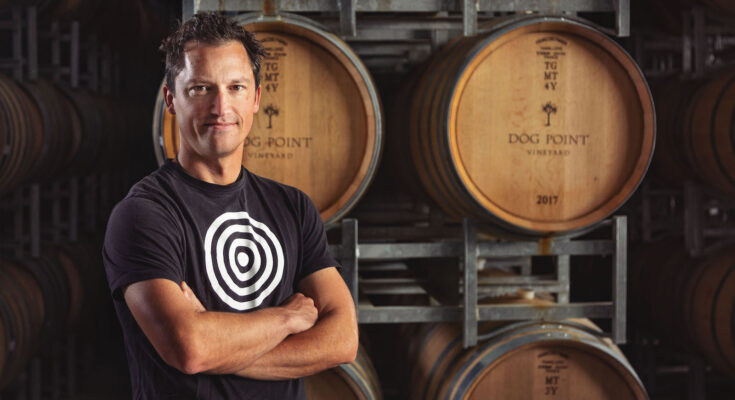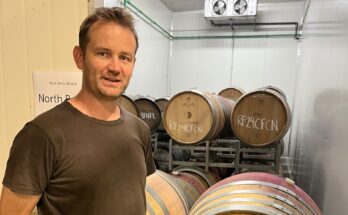I planned to be in Marlborough on “International Sauvignon Blanc day” – as you do. The New Zealand wine industry owes a huge debt to this one style of wine. Not just Sauvignon Blanc, but that very specific expression of the varietal coming from Marlborough, that has been embraced by the global consumer. Whilst it has devotees in this country, all too often you’ll hear ‘serious’ wine drinkers saying “I don’t touch the stuff”. Not so here – I’m a big fan. And it deserves to be taken seriously. For as many mega-tanks of savvy destined to be shipped overseas, there are smaller producers making ‘interesting’ versions of it. Much of the difference resides in the vineyard, where the methods of growing have a profound effect on the grapes that become the wine.
My second stop of the day is at Dog Point – started by a couple of families with ties to Cloudy Bay – the Marlborough pioneers, and a label that I associate with an excellent example of Sauvignon Blanc. One that I more often than not find on top of many a restaurant wine list. I’m also a fan of their other three wines – they only produce four (that I know of) – the plush Pinot Noir, an age-worthy and complex barrel-fermented Sauvignon Blanc and a flinty, juicy Chardonnay.
I’m here to have a poke around the vineyards – I confess I tend to lose my bearings in Marlborough’s valleys! – and chat with winemaker Murray Cook.
Murray Cook: We can do a lap around the vineyard if you like. The weather has been superb – a bit like last year where the summer sunshine just carries on right into autumn.
Ivan and Margaret Sutherland started the company with the Healys, back in 2002. So, Matt who you’ve met is second generation. They bought this land back in 1991 and their first vineyard was just across the road, which we’ll go past in a minute. They were part of the pioneering group that started in Marlborough. Down here is an important part of our block, which is Section 94. We just make four wines – we’ve got our classic tank-fermented Sauvignon Blanc, then the barrel-fermented Sauvignon which is coming from that square-shaped block straight out in front of us – one of the first parcels planted, in 1992.
We’ve got some younger vine Sauvignon out the front here, a narrow strip of Chardonnay, and then Section 94, then back to Chardonnay, and more Sauvignon by Brancott Road. And there’s Pinot Noir down by the driveway. We’ve focussed on those three varieties, and I think for Marlborough they are really consistent year-on-year. Pretty much all of the Pinot is coming off the hills behind us, as well as two other main Pinot Noir vineyards on north-facing clay-based hill slopes. We’re in what’s known as the Southern Valleys sub-region of Marlborough, and we are between the Brancott valley and the Omaka Valley.
WineFolio: It’s been so dry recently, but I did hear that rain is coming. And crops have been light this year?
MC: Oh, so light! We’re probably 50% down on Sauvignon and Chardonnay. Pinot would have been too if we hadn’t kept some extra vineyards back. We use about 30-40% of what we grow to make Dog Point. The rest we sell to about a dozen other wineries around the region, both large and small.
WF: I heard it’s a big property, and am I right in thinking it is the biggest organic vineyard?
MC: Yes, New Zealand’s largest organic vineyard – we’ve got 280 hectares certified organic. And a few, more recent purchases, that are getting some re-planting done and then they’ll be converted as well. That organic path started for us in 2009, when the first stage on conversion happened. At that stage it was 150 hectares and did all of it in one go, which is not very common. I think when you dive in like that, it becomes the norm, and no-one really questions it. It is a brilliant climate for organics as well – we have a huge amount of sunshine, high UV intensity and it is usually pretty dry through our growing season. The biggest challenges are weed control but we use a lot of under-vine cultivation for that. And then disease control, but with good wine and high sunshine and light, that is favourable for keeping disease at bay.
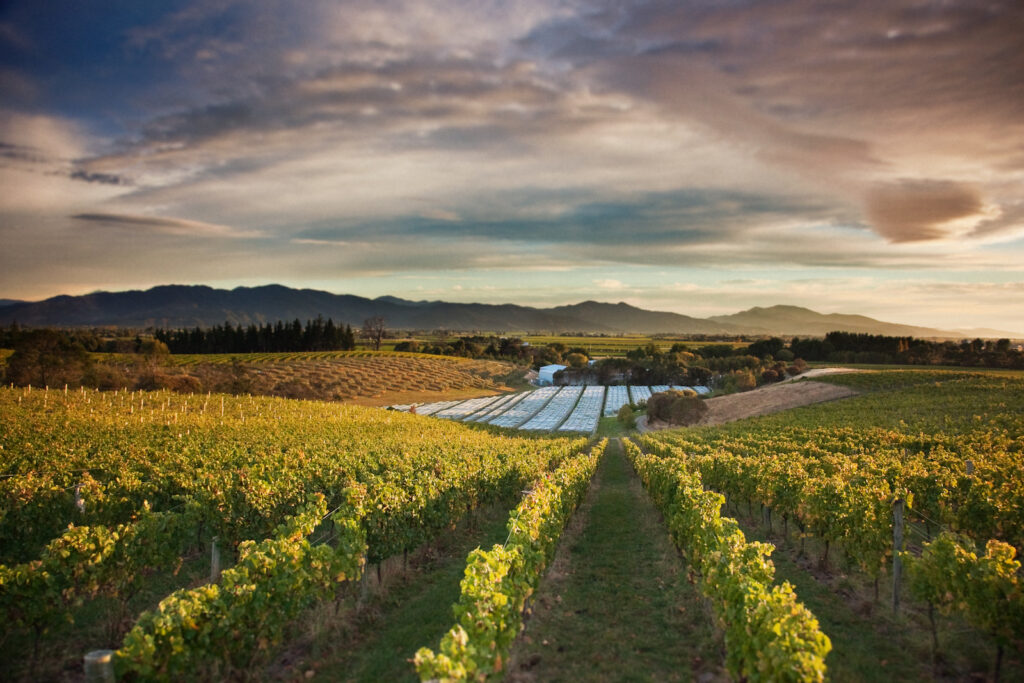
WF: Do you use much water?
MC: We do irrigate, depending on the season and how much it needs. Up on the clay soils they hold a lot more, but come late summer when the vines are starting to get stressed, we do irrigate. We use Southern Valleys irrigation Scheme for the large portion of it, which is fed out of the Wairau Valley.
WF: So you obviously could create more wine if you needed to?
MC: The chance is there, but with the guys having left larger wineries earlier in their careers, they didn’t have that desire to build it up bigger than what could be managed within the families. We’ve reached a size now where we are pretty comfortable and sustainable within the model that was set up.
Typically it is about 60,000 cases. 50,000 of that would be the Sauvignon, and then the barrel wines make up the other 10,000. However, the last couple of years have been about half of that. COVID hit and we realised that our bars and restaurants market was going to be struggling, so we made the call to shrink our production quite significantly in 2020.
WF: It is such a great wine-list wine. The first wine on so many restaurant lists is Dog Point Sauvignon Blanc!
MC: We made that call, and at the time it felt like the right decision. But as the year played out – sales tanked at first, but then came roaring back; and you just had to be adaptable and ready for anything. A pandemic makes people thirsty. UK, Australia and US are our top three markets since forever. We’ve got new distribution in China, and about 50 markets in total globally.
WF: And Marlborough Pinot – that’s starting to get a decent reputation as well.
MC: I think Marlborough Pinot probably got off on the back foot, when the plantings that were originally there were probably heavier cropping Swiss clones made for sparkling; and on stonier, flatter sections of the valley. Better vine material – Dijon clones – arrived in the ‘90s and after that the hill slopes started to be planted, in the clay, where Pinot thrives. The focus has always been on Sauvignon, and fair enough – it is an incredibly important variety for us. But, we love pinot too! I think Marlborough has come a long way.
We’re also part of the New Zealand Pinot community, where there’s a whole lot of knowledge sharing as well. There’s a couple of workshops that happen – the traditional one down in Hanmer. It’s an open forum and you don’t always play your best card – problem wines… or great wines! I think it is one of the reasons why New Zealand wine has skyrocketed in terms of quality in a really short time.
WF: So, as winemaker – what was your path to here?
MC: I have been here since the end of 2013. During 2013, James was quite sick, and it prompted James and Ivan to start planning into the future a bit more. They realised they weren’t going to be able to do the heavy lifting forever. Ivan’s eldest daughter, Anna, is General Manager of all the vineyards. Kirsty Sutherland does all the design – she designed the original label when they started in 2002. Matt is General Manager of Dog Point wine and brand. And they are all Directors on the Board as well.
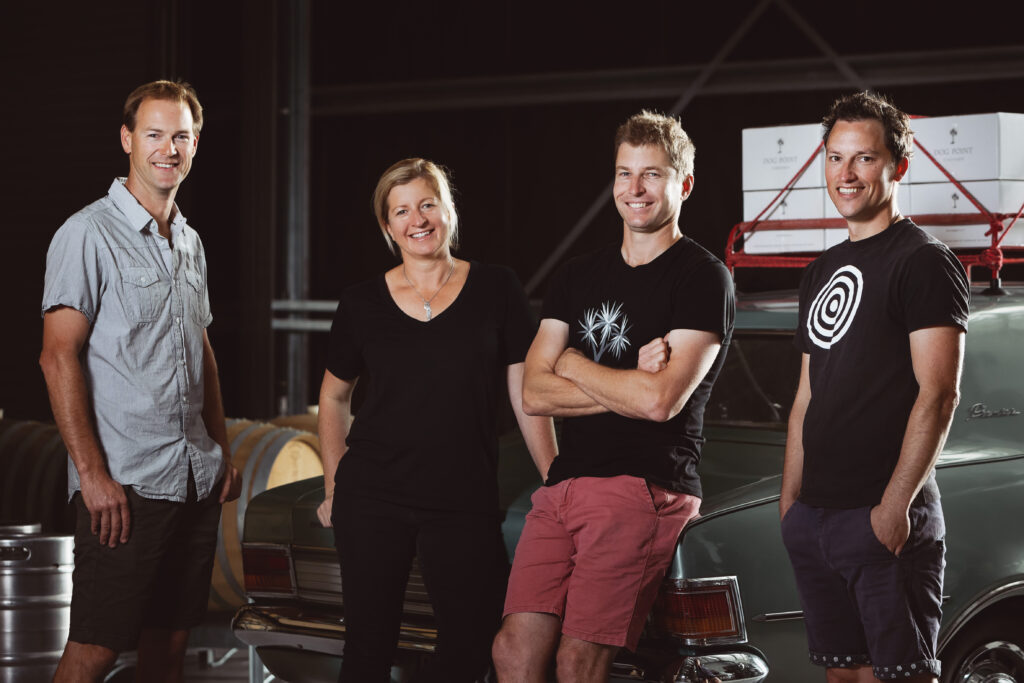
Nigel, Anna, Matt, Murray
Coming into the business, it is an incredibly strong wine brand, with wines that are all something that I wanted to work with ever since I’d been in Marlborough. It was 2008 that I came across from Melbourne, working in the Yarra Valley there at Yering Station. Worked at Villa Maria Marlborough for five years as a winemaker.
WF: I do love Villa Maria’s single vineyard wines. Well, from the Hawke’s Bay and Marlborough reserve wines, up to something like Taylor’s Pass Pinot. And I’m a fan of their Chardonnay range.
MC: I caught up with Dave Roper a couple of weeks ago. He’s such a good guy.
WF: He is a great bloke to have a yarn with. And then, just last week I spent an afternoon over at Simon Nunn’s place – he’s a hoot as well.
MC: Yes! I’ve judged with him at the New Zealand International. He flogs his chutneys! Was he doing that at the Easter Show?
WF: Yes, he was, hahaha. I did stewarding at the New Zealand International, but I’d like to do more judging. I said to Kingsley that I don’t mind doing stuff that other people aren’t bothered about. Everyone wants to judge the Pinot and Chardonnay and bubbles, but I’m happy to do Pinot Gris, and I love Sauvignon. Some of it is under-rated quality-wise, I think. There’s a few really good Pinot Gris out there now. Aside from what you’re doing here – is there anything else that you think has a great future in New Zealand?
MC: I think Syrah, just that the amounts are tiny, so it is never going to reach as far as the other wines do. The Bordeaux blends as well. When you look at them on a world stage they stack up really strongly. But, with what can often be a marginal climate, it is still where you sometimes get top quality wines – where it’s not always possible to ripen. Even here in Marlborough – the last few seasons have been kind, but it is not always like that. You can get really exciting wines from marginal climates though. Albarino gets a lot of chat and talk.
WF: Yes, it does, and it is good. Not to everyone’s taste though – would you drink it over another white varietal, usually? Viognier is another one.
MC: Largely we are talking about French varieties, but we’re so young that it is hard to know what the limits are for quality wines.
WF: Do you benchmark yourselves against other wines? Get in bottles of things that you really like and see how your wines stack up?
MC: Definitely. I think it is super important to be tasting as widely as you can. And to know where you fit in, on the world stage, but also locally as well. It is dangerous to be stuck in a bubble, and not taste as widely as you can.
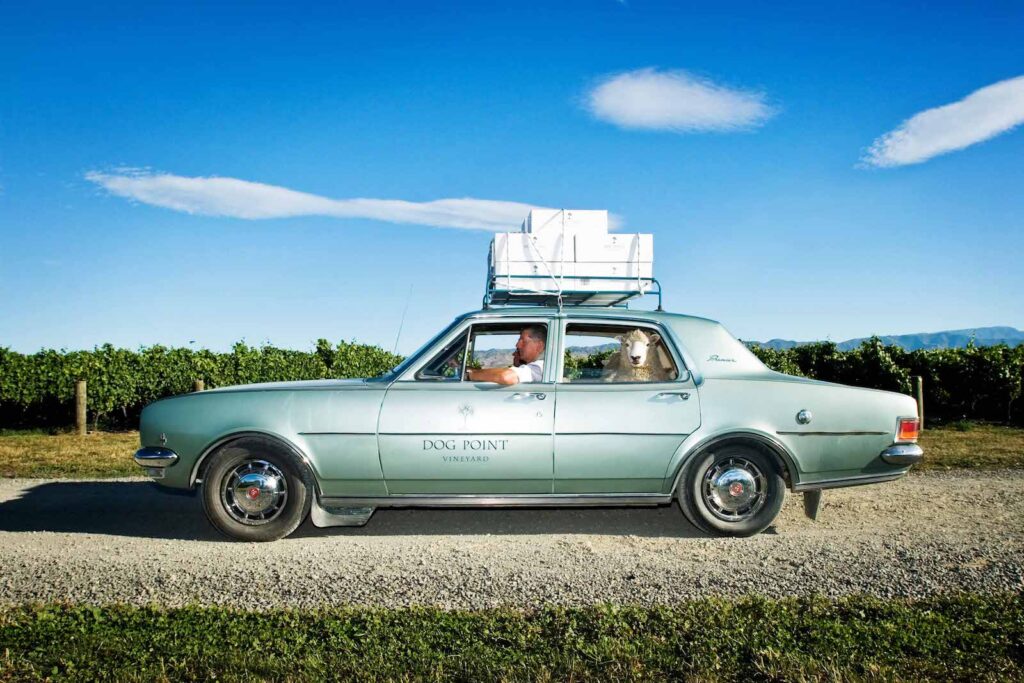
This is our Settlement Vineyard – we’re a bit further down the Omaka Valley now. Another important block for us – predominantly for Pinot Noir, which is all up on these hills, and a bit of Sauvignon Blanc down on the left. The Omaka Valley is one of the smaller valleys, but it has a few plantings. This one here was where Mike Eaton planted after he planted the Clayvin Vineyard in 1991 – an iconic vineyard. I think it may have been Marlborough’s first hill-slope vineyard, and now it is mostly Pinot Noir on the hills. There’s a mix of plantings on the flatter sections, which will be mostly Sauvignon Blanc.
WF: Is wind an issue around here?
MC: It can be. Anywhere where we have exposure to wind, we have trees planted to shelter it. The wind works more in our favour than it does against us – in lowering disease pressure.
WF: And has your winemaking changed much over the years?
MC: I think one thing that has changed is that we’ve always pushed the boundaries in terms of reduction in the wines. Particularly in the Chardonnay and the Section 94, and in recent years we’ve been more aware of how much is there – and just trying to keep it at a level where it is there, and keep it exciting – and in our style – but not going to be too confronting. The inclusion of solids is the main factor in that one. Starting to include a little less than we have previously.
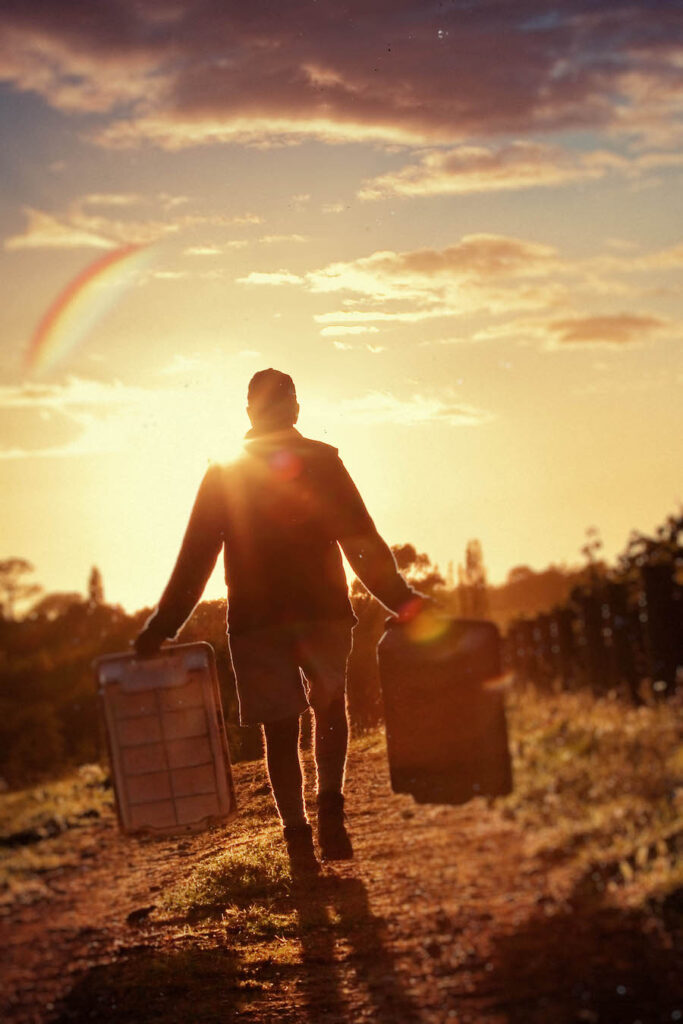
credit: Jim Tannock
WF: There was that development a few years ago, of what I’d call ‘the modern Chardonnay’ where you heard of bottles being returned to shops as faulty… but I think it was adopted quite quickly, and wines with those styles won some big awards.
MC: Unfortunately our oldest block of Chardonnay is coming out this year. It is still on its own roots, from 1981, and phylloxera has just taken too strong a hold of it, and for years we’ve tried to keep it going. It was a really good block of Mendoza Chardonnay, but it has lost the battle. Chardonnay will go back in.
WF: Do you use much new oak?
MC: Try not to, and Pinot gets the lion’s share when we do get new barrels. As a variety it is able to hold its own against oak, more than Chardonnay. And there would be hardly any in Section 94 – just the odd one to replace an old one that is falling apart. Chardonnay gets about 10% new oak.
We arrive back at the winery and settle into a tasting…
WF: No rosé? You didn’t get the memo? Hahaha
MC: Yeah, I know – it’s so hot right now isn’t it? Who knows what tomorrow will bring. It goes so quickly too. We’ve kept it focussed on those four.
When we drove around we saw those two vineyards – the Estate and the Settlement, but we’ve got eight vineyards in total – all within about a 4km radius. The furthest one is just behind Cloudy Bay and that’s the stoniest of our vineyards. The rest of our Sauvignon comes from around here on siltier clay-lime soils. There’s always a degree of stone in there where the glaciers have carved out the valleys. The heavier soils tend to impart a bit more body and texture into the wine. We get a more citrus-dominant core of flavours from our Sauvignons, but in a cool year like ’12 you’ll get the more herbaceous spectrum. Sauvignon tends to really show the vintage. More than the other two, I would say. Then in a warm year like ’19 you’ll hit more tropical tones.
WF: I do tend to look at Dog Point as one of those Marlborough Sauvignons that has the identifying factors in place, but it doesn’t necessarily swat you round the face with it. There’s a subtlety and depth to it, that can take a few seconds just to take it in, and work through the minerality and the texture. It’s calmer and more characterful. And I do often see mandarin and tropical fruit as well as the usual blackcurrant, passion fruit and so on.
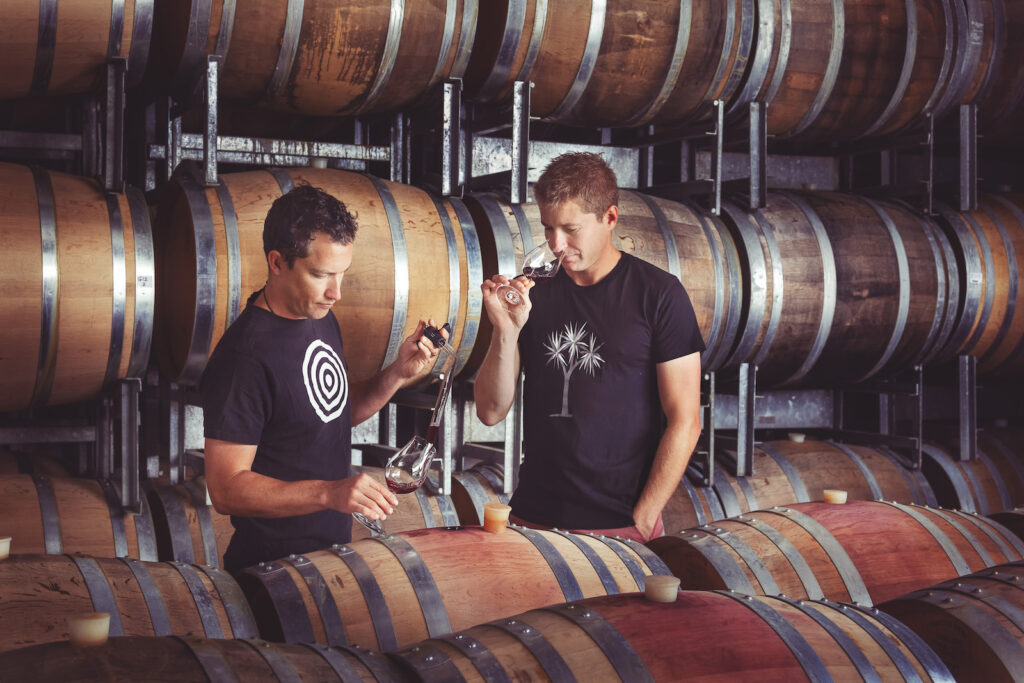
MC: That’s good to hear because it is certainly something that we chase, is to have layers of other flavours in there. For us – handpicking, which is 100% for all of our wines. Whole bunch pressed into stainless steel and it stays in tank for about four months typically. A portion of it – about a quarter of it – goes through wild ferment. We love what that brings too, with flavours other than primary fruit. So you end up with more of those floral and earthy tones as well. It’s a tool to pare back that fruit and make a wine that’s a bit more subtle.
2020 was the COVID pandemic year and the challenges of dealing with that. For Sauvignon we’d typically have around 100 hand pickers, and when social distancing measures came in we realised that we might have troubles! We were pretty nervous actually. Everyone was figuring out how it was going to work.
We actually discussed whether we would have to machine harvest, because we didn’t think we’d have people around. So we planned for it, but as each day went by we realised we could get by. We peaked at about 70 pickers, and doing less tonnage per day, but it was just endless sunshine.
Then we get to this year, and we looked for someone to help us out in the Cellar – and we couldn’t find one! So we brought in a couple of people from the vineyard which worked out really well for us. Finding people is a real challenge with the borders closed. It is usually United Nations in town at this time of year. You certainly realise what you miss out on when a pandemic closes your borders. 2021 was incredibly early – we were harvesting our first Pinot on the 24th February. We had our earliest start date and then our earliest finish on 30th March. Very small yields but another great season in terms of weather. Quality is awesome.
WF: Where does that leave you then – you’ve worked to make it on to lists of restaurants, but how do avoid not running out?
MC: With great difficulty. That is farming. When it is there, its there.
WF: What about consumers though? They hear something like “a good year” and what does that mean? Does it mean really bumper crop, or does it just mean better quality?
MC: Ivan has seen a few vintages, and he said he’s never seen one like this, so it is a real outlier in terms of yields. Just way smaller than anyone would have predicted. It would be interesting to see if anyone has looked into what did actually happen. For the Pinot I know we had some patchy flowering, so I can understand that being smaller than usual. There was a lot of hen and chicken, in both Chardonnay and Pinot. But the Sauvignon had looser, smaller bunches and not many on each vine. Whether that’s the result of three years of drought that we’ve gone through, or other factors like frosts at play, I’m not sure?
With organics, now there’s a huge focus on winter cover crops to try and increase soil health and give back to the soil. Hopefully the vines have enough reserve there.
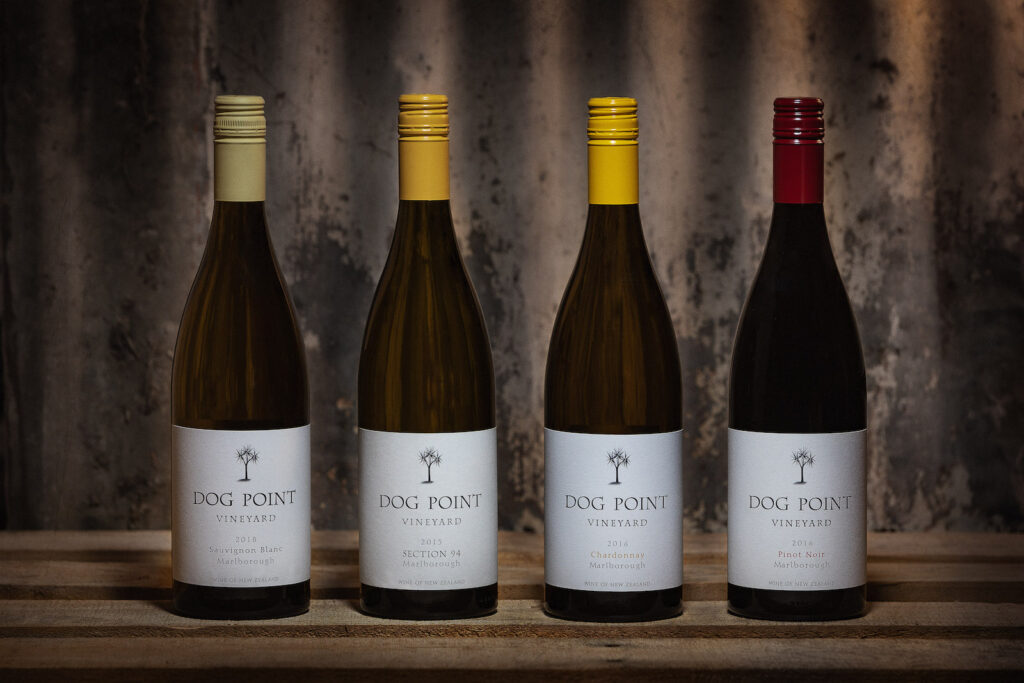
WF: One question I’ve asked almost everyone I interview – over thirty years of doing it – is this… What’s the best thing about doing what you do for a living – as a winemaker?
MC: The other people around. Wine is a social product and it just surrounds you with good people. Whether they are growing it, helping to make it, or selling it, and drinking it at the other end. Wine is just a product that puts a smile on people’s face. To be involved with that – it is a huge part of my life. Pretty much every book I read at home is about wine as well! You’re into it or you’re not. It can fully consume you.
WF: And any given part of the year that really brings home that feeling?
MC: Harvest is the time when your adrenalin kicks in. It’s exciting. You get to see what the season will deliver. Whether it is what you think it would be, or if it will surprise you. And quite often it is surprising.
So, on to Section 94! When Dog Point started Ivan and James were still doing their day jobs at Cloudy Bay, so the first two vintages were made at Cloudy Bay in 2002 and 2003. Then 2004 was their first stage of the winery here. They laugh about ‘the winery’ back then as it was basically a shed full of barrels and a press and that was it. Everything is still pretty simple. It’s about what happens on the vine first of all, then handpicking and taking care. Leaving those three barrel wines alone to do their own thing.
WF: With something like a Section 94 – is it possible if I say I think I’ve got a bottle or two back as far as 2005 – is that possible? Because I’ve been a fan of Dog Point for over ten years, and I’m pretty sure I bought some back then and it would have been around that vintage?
MC: Totally. They are still drinking well. We don’t have many of them out the back. In 2014 we did a “Decade of Dog Point” and went around the world showing those. Which depleted a lot of that old stock.
WF: I just clocked your Kumeu River box – I went to their 75th Anniversary tasting last year. That was amazing – I love Kumeu River. And, I guess such good value for a world-class wine. It does irk me sometimes that people will spend over $50 on a fairly average bottle of Champagne, but won’t spend that on a really, really good bottle of New Zealand still wine.
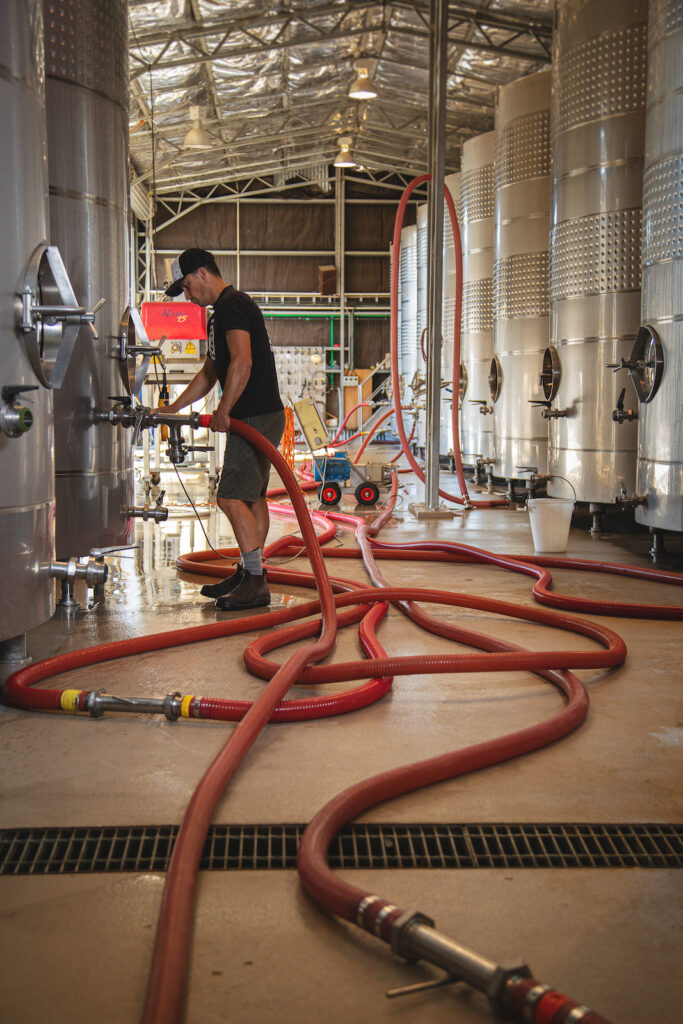
Also, what do you think of New Zealand sparkling wines?
MC: Awesome. Although what Champagne has done is created that ceiling of price. Not many makers of New Zealand sparkling go beyond that $60 mark.
WF: Yes, and with price comes expectation. Joe Public buys a $60 wine and they think it will be three times as good as the $20 one. It doesn’t work like that! Once you’ve got something that is 95% amazing, you’re only left with another 5% of improvement and it is down to tiny degrees. I don’t know if I will ever score a wine at 100-points for example. I’d like to. I’d love to think it is out there!
MC: And a 95-point wine is already really good, so what is perfection? If I was asked to describe that, I don’t think I could. But for sparkling – even if you’re looking at those base-level Champagnes… they’re pretty patchy and not always that great. The best of New Zealand can definitely out do them. There’s a few producers out there that we definitely love to drink. Quartz Reef would be right up there. Their vintage Blanc de Blanc is pretty special.
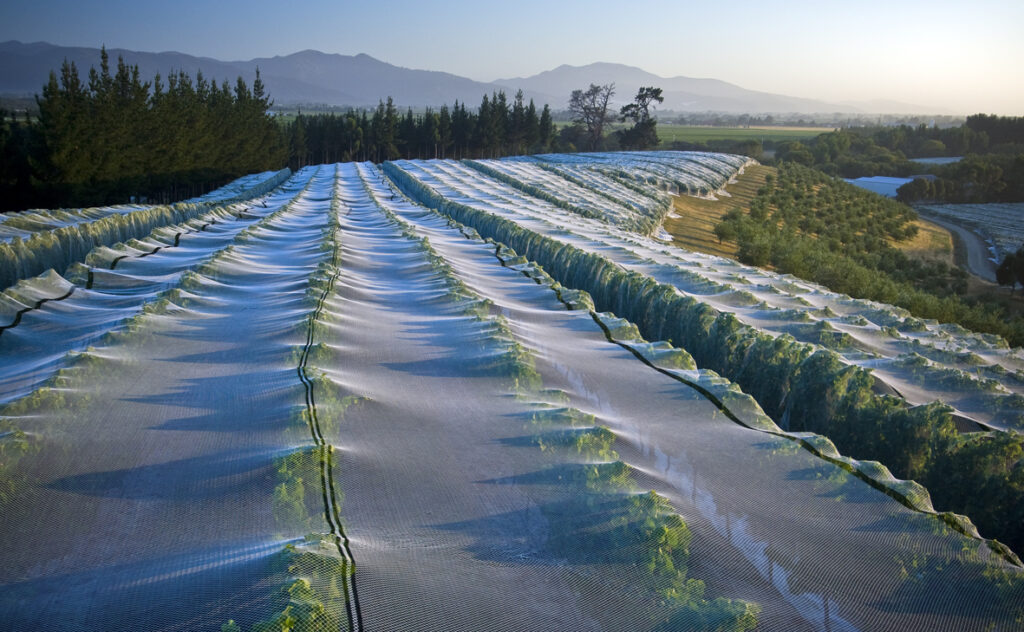
This is our current Chardonnay. The reductive character can polarise an audience, but it is something that we’ve done for a long time. When you do include those solids, without any clarification or settling of the juice – it is common to see it as a result when you bottle it.
WF: As long as it doesn’t become overpowering and adds interest, then I’m not against it. It adds something – another layer of complexity. Obviously there are plenty of styles to choose from, and it might be a bit of a minefield for a consumer, as things develop and styles push on.
Take New Zealand Pinot Noir for example – I’d say that has changed quite a bit over the first decade – from makers thinking what ‘they can do’ around to what ‘they should do’ – with lower yields, better clones and sites and more sensitivity around the winemaking. I still drink a bit of Burgundy, and I have to say, that New Zealand is really starting to stack up against some wines with fairly big reputations.

